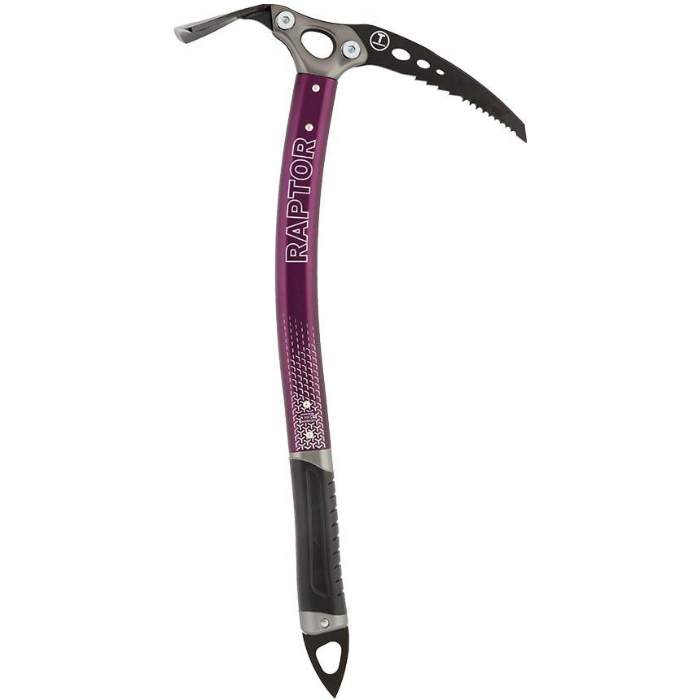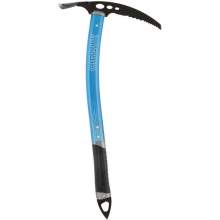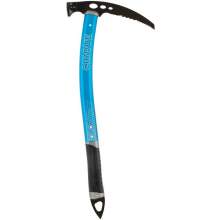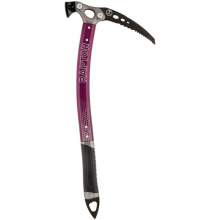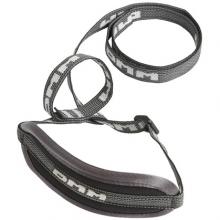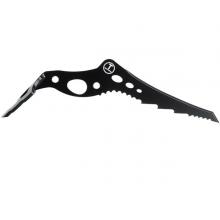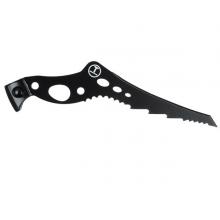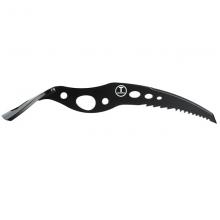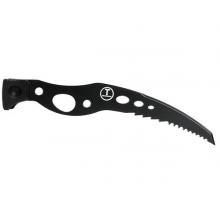Warnings, general information, maintenance, servicing, lifespan and instructional pictures.
Raptor Adze
Description
The gentle curve in the shaft gives clearance when swinging without compromising the Raptor’s ability to self arrest.
A full size hammer and adze make light work of cutting steps and ledges and bashing in pegs for security. The spike on the base of the handle rounds out the Raptors mountaineering capability by giving security on snow and ice slopes.
For those wishing to venture into steep terrain the Raptor can be fitted with a Fly pick that improves climbing performance. A Choke Hold Leash prevents you accidentally dropping the axe, and allows resting opportunities if climbing steeper ground.
Picks on the Fly and Raptor are interchangeable, allowing you to customize the axes to improve performance on either steeper or more traditional terrain. Fly picks are more aggressive for climbing steep ice and mixed, while the Raptor's Alpine Pick gives better self arrest performance.
The Raptor comes with our Choke Hold leash, keeping the axe firmly secured to you in case of an accidental drop and making it easier to climb steep terrain.
Retail price
This Product is Hard to Find.
We don’t know where you can buy this item online in the US. We’ll continue to check all the major retailers and will update this page as soon as we find one.
If you know where to find this online in the US, let us know, and we’ll add the link.
Weight (g / oz)  Weight (g / oz)In grams and ounces, the weight, as stated by the manufacturer/brand. Since the most common ice axe length is 50cm that is the main length that we reference. When available, we list the weight for each length here. | 644 g / 22.72 oz 50 cm: 644 g / 22.72 oz |
Best Use  Best UseUltralight MountaineeringThe lightest axes available, used most for ski mountaineering, adventure racing, and other "go light" ascents. 350 grams is usually the max weight. The decreased weight means they are axes are built for snow missions, not ice. MountaineeringThis is the most common type of snow mountaineering axe. These axes are above 350 grams and are a great balance of weight and durability. There may be a grip and they will always have an adze head (and no matching hammer pair). These axes are great for snow and can handle chopping steps in ice, or other small ice scenarios. Technical MountaineeringThese axes are for tougher conditions when the majority of climbing is on snow, but the axe needs to be able to handle a short ice wall. They generally have a bent shaft and T-rated (more technical) pick. Often these beefier axes will have a rubberized grip and they may have a matching adze and hammer version. They're basically the offspring of an ice axe and ice tool. |
Technical Mountaineering |
Length Options (cm)  Length Options (cm)Measured in centimeters, the best length is based on your height and ape index (arm length). Holding the axe in your hand, the spike (sharp end) of the axe should arrive around your shin. At the max size, it should go to your ankle. Two people of the same height could need a different sized axe, based on arm length (t-rex vs monkey). If in-between sizes, our bias is towards sizing shorter. Rule of Thumb
Worth ConsideringThere are other resources online that suggest a longer axe is a plus and that you should measure below the ankle. We absolutely disagree. A longer axe means you'll be tempted to use it as a trekking pole (which will put you off balance), or you'll have to give your arm a huge workout just to lift it in and out of the snow. Ice axes are meant to be used on the uphill side, which is already much higher. |
50 cm, 55 cm |
Head Details  Head DetailsThis refers to the back of the ice axe head (opposite the pick). 
For ice axes, adze's are (by far) the most common. An adze will allow you to break ice by chopping or shoveling in a specific area, and they also provide more room to hold on to the head than a hammer does. This grip helps for arresting too. Hammers are usually only used as a pair with an adze on the other axe (hammer's are much more common in ice tools than ice axes). A hammer uses a more broad force to break ice bulges. | Adze Pair axe: Raptor Hammer |
Ice Rating  Ice RatingThe certified rating of the pick and the shaft. These ratings might not match each other. There are only 2 possible shaft ratings: B / Type 1 / CEN-B: Basic | Pick: T / Type 2 Shaft: T / Type 2 |
Materials  MaterialsThe materials, as stated by the manufacturer / brand, of the pick, head, shaft and grip. | Pick: Steel Head: Steel Shaft: 7075 Aluminum Grip: Injection Molded Rubber |
Certification  CertificationsThe main climbing gear certifications are CE and UIAA--and normally the UIAA creates the rules that the CE body also supports. When possible, we try to list all the certifications the product carries. To sell a climbing product in Europe, the device must be CE certified. There are no official requirements to sell climbing gear in the US. The UIAA certification is a voluntary process. For ice axes, there is a separate certification for the pick and the shaft. Learn MoreRock and Ice Certifications Guide |
CE, UIAA |
Warranty  WarrantyThis isn't super common, but sometimes the manufacturers will state a specific warranty such as "3 years against manufacturer defects" |
|
No reviews yet.
At £125 the DMM Raptor is not a budget option, but its price is roughly on a par with similar models from other well regarded brands. Since this is an axe that's built to last, you're going to get years of service for your money. Its relatively high weight may be a little off-putting on paper, but in use it reflects its general sturdiness, and the T-rating that makes it suitable for use in belays. A refined design makes this a superb all-rounder, with plenty of technical juice in the tank for classic mountaineering, yet without being overkill for hillwalking on less steep terrain. If you were only going to buy one axe for everything from winter Munros, through Scottish grade Is and IIs, to Alpine normal routes, then I can't see anyone regretting a Raptor. While I'll always have a soft spot for the original, the much improved current version looks set to be my new favourite axe for years to come.

